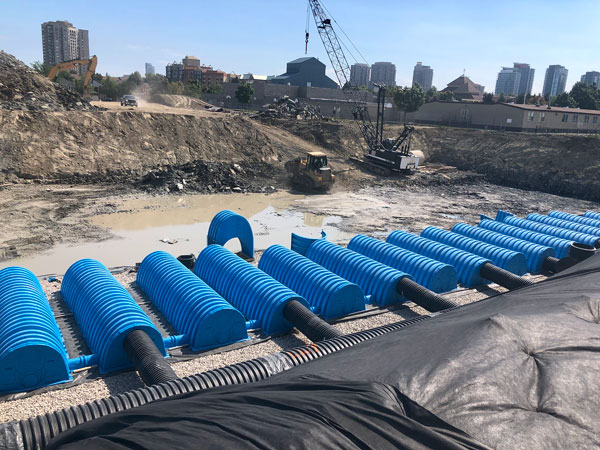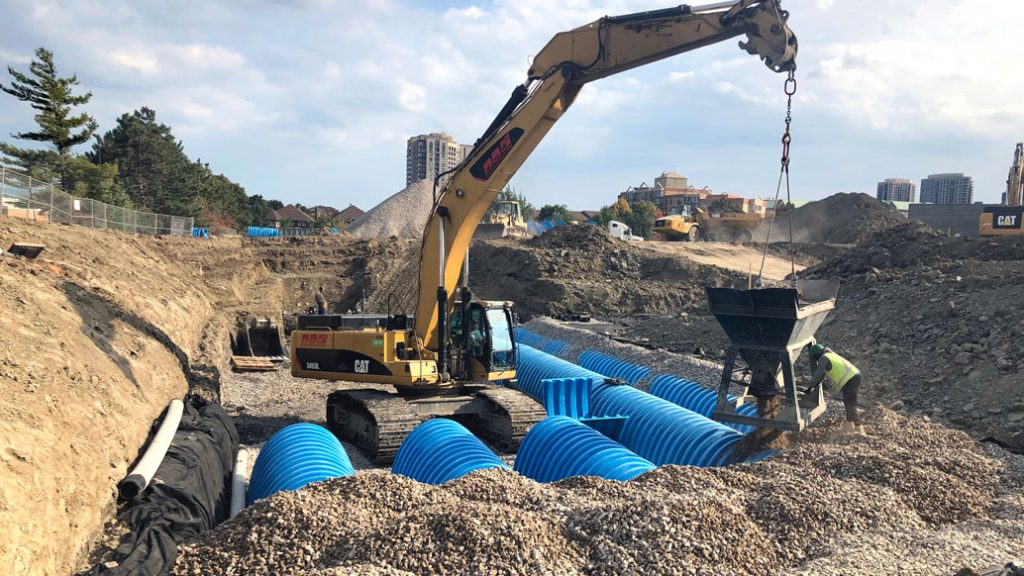Residents of the Hurontario community in Mississauga, Ont. have been participants in a multi-year, multimillion-dollar undertaking to control flooding in the city’s Cooksville Creek watershed.
In June of last year their local 1.2-hectare Sandalwood Park was closed to facilitate the installation a 15,000 cubic metre underground storm management facility approximately four to six metres below the surface by ConDrain Company Ltd.
However, within a few months those residents should be able to kick some soccer balls, go for a stroll or test out a new playground the city will be erecting as part of the park’s restoration.
“We expect that the project will be substantially completed by June 30. Restoration is underway and the park should be opened by the fall,” says Elizabeth Dollimore, a drainage engineer with the city’s environmental services department.
Designed by Resilient Consulting and comprised of more than 4,310 Copolymer Polypropylene resin chambers, the purpose of the huge underground complex is to hold back stormwater and then slowly divert it back into a nearby trunk sewer in the event of a greater-than 10-year-storm, says Dollimore.
Manufactured by plants in Cobourg, Ont. and Wisconsin, the lightweight chambers were hand-installed by a small crew after the park had been excavated and then were covered with stone and earth.
Located adjacent to the Frank McKechnie Community Centre and flanked by two schools, Sandalwood Park is in the middle of a residential area and burying the chambers below the park had its logistical challenges, “especially minimizing the noise and dust disruption,” she adds.

Asked how the city obtained community buy-in on a project that denied them the use of their local park for more than a year, Dollimore says a public information centre, along with notification letters, kept the community informed and onside.
“We were able to address residents’ concerns,” says Dollimore, citing the city’s commitment to install the new playground as one example.
Consultations were also held with the principals and staff of the two schools, she says.
“The idea was that we would start (construction) in June when the schools are closed. Of course, with COVID, the schools have been closed most of the time.”
The installation of the underground facility was basically a repeat of one installed a few kilometres away at Eastgate Park in 2018.
That same year it won the Ontario Public Works Association’s 2018 Public Works Project of the Year Award (Disaster, Emergency Construction, Repair, $2-$10 Million category).
Along with the already built 11-hectare above ground Cooksville Stormwater Management Pond in the middle of an industrial park north of Matheson Boulevard West in the headwaters of the creek, the Eastgate and Sandalwood facilities are part of a planned network of similar facilities to be built at five other Cooksville Creek watershed parks over the next several years, she says.
Design work for flood control systems at two of those parks, Mississauga Valley and McKenzie Park, is underway.
The catalyst for that network was a massive storm in 2009 that caused the flooding of approximately 400 area homes in 2009.
In the wake of that event, the city launched the Cooksville Creek Flood Evaluation Study Master Plan Environmental Assessment. Conducted between 2010 and 2012, the study identified the parks as the ideal locations for underground stormwater control systems.
By utilizing municipally-owned parks the city avoids the expensive costs of purchasing land while maintaining the communal benefit of the parkland, says Dollimore.











Recent Comments
comments for this post are closed